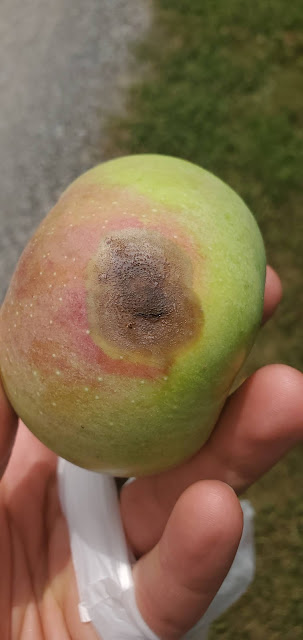First signs of apple bitter rot disease on fruit of apple cultivar ‘Wolf River’ have been found in the Shenandoah Valley, more exactly in Martinsburg WV, Berkeley County (Fig.1). Rot started from the fruit side (Fig. 1 bottom) indicating that it probably started as an established quiescent Colletotrichum infection at bloom or petal fall, that then expressed recently. We found that bitter rots were almost always on fruit in dense clusters with many fruit together indicating on the conducive moisture conditions on these clusters and lack of fungicide coverage on fruit penetrating in between the fruit (Fig. 1 top). Bitter rot fungi can infect any fungicide-uncovered areas on fruit, especially when warm wetting events occur, and we had severla of these in the last 15 days. Extreme heat and the rain that "came" back this week has and will extremely favor this disease in the weeks preceding harvest. Start scouting for bitter rot symptoms to make sure you are free of this disease and to make sure how well was your fungicide coverage during the early summer cover sprays.

 |
| Figure 1. First signs of bitter rot on ‘Wolf River’ apple fruit near Martinsburg WV (Photo by Aćimović S. G. 2021). |
We hope you will NOT see any bitter rot in your blocks and that your fungicide coverage was satisfactory. If by you see bitter rot on some fruit, especially on highly valuable crop like 'Honeycrisp', our recommendation is to protect the whole block by immediately spray applying the full rate of captan plus higher rate of Pristine or Merivon or other QoI containing fungicides such as Sovran, Flint, Luna Sensation or similar. We would also recommend to include a surfactant such as LI-700 to enhance fruit coverage (use low rate for coverage only!). This will help both to inactivate spores on the decay lesions and to protect the remaining healthy fruit from infection until they can be harvested. We warn that if fruit will be sold for pick-your-own, then the full rate of captan close to harvest may be a problem and one might get by with a half-rate of Captan 80 plus a full rate of either Pristine or Merivon (read the labels and PHI limits of these fungicides). After harvest, strive to pick all of the decayed fruit from the the orchard floor before winter and destroy it by burying the fruit. If the bitter rot affected block was a block that had fire blight last year or this year, it will also be important to cut out and remove all of the dead fire blight wood because bitter rot likes to colonize old fire blight strikes.
Comments
Post a Comment